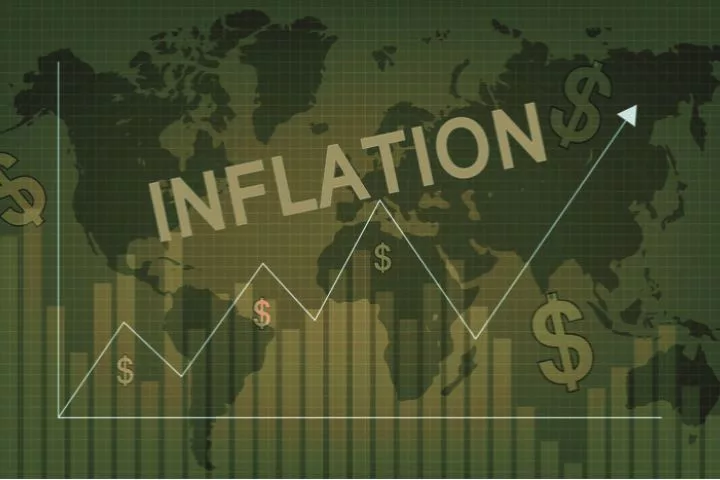How Inflation Is Trembling The World Economies And The Prices Are Rising

Everyday life is becoming increasingly expensive – that’s why there’s always talk of inflation. But what exactly is that? A small encyclopedia for costly times. Inflation in the world is rising, as is the case in many other countries.
This isn’t very pleasant for consumers because their money loses value. But what exactly is inflation? What does a central bank like the ECB have to do with it? And how can you protect yourself?
What is inflation?
Inflation describes the fact that most prices in a country are increasing. It is measured by statisticians, for example, at the Federal Statistical Office.
Month after month, they observe what a specific average shopping cart costs. If this becomes more expensive, the purchasing power of money decreases – for example, you can only buy two bananas instead of three for one euro.
When people talk about inflation, what is usually meant is the so-called inflation rate: It describes how much the price level has changed compared to the same month in the previous year.
What is deflation?
Deflation is the opposite of inflation: prices don’t go up. They go down. In Germany, there has hardly ever been deflation in the past, and costs only fell significantly during the economic crisis of 1929.
Deflation is also not desirable: if prices fall month after month, consumers may postpone purchases further and further into the future. Nobody currently goes shopping anymore, which causes domestic demand to collapse.
What types of inflation are there?
Ultimately, inflation is usually the result of an imbalance between supply and demand – for which there can be two causes:
On the one hand, it increases when a specific range of goods becomes scarce. Examples of this are oil price shocks or supply chain problems, resulting in companies increasing prices.
On the other hand, it rises when demand suddenly increases. This can happen if, for example, the state gives away money to its citizens or the central bank pursues a monetary policy too loose.
Even then, companies have the opportunity to raise prices because demand is already high.
What do central banks have to do with it?
It is up to central banks to keep the value of a currency as stable as possible – because it fluctuates depending on numerous factors. This is a constant balancing act for central banks as they must avoid high inflation and deflation.
The European Central Bank (ECB) is responsible for the euro, and its inflation target is 2 percent. The important thing is that as long as the ECB achieves its inflation target, it can, according to its statutory mandate, also support the economy: because low-interest rates tend to promote economic growth and ensure low unemployment.
How does monetary policy work?
The ECB cannot control inflation directly. Instead, it uses a so-called monetary policy: high-interest rates can reduce the demand for goods because credit becomes more expensive.
On the other hand, low-interest rates mean cheaper credit and, therefore, higher demand for goods and services.
What are prime rates?
How monetary policy works in detail is a very, very complicated matter. But, a central bank has to issue money to commercial banks regularly to provide economic credit. But central banks don’t give away the money; instead, they charge interest on commercial banks.
And if a central bank increases these so-called key interest rates, commercial banks can only grant more expensive loans – which slows down demand for goods and services and thus inflation.
In such cases, one speaks of an interest rate increase, sometimes restrictive monetary policy.
What’s the deal with the money supply?
The view that the so-called money supply plays a central role in inflation is now considered outdated. For a long time, there was concern that excessive money would lead to inflation.
The underlying fear was that a central bank could print too much money. Economists doubt whether that would be a problem because the connection between the money supply and inflation cannot be proven.
Why are so many talking about a wage-price spiral?
Central banks don’t just act in line, which is always based on historical data. Instead, they also work with forecasts of future inflation.
One of the most critical factors here are so-called second-round effects: once inflation is high, it could trigger further price increases in a second round.
This becomes clear with the so-called wage-price spiral: when prices rise, workers may demand higher wages, forcing companies to make further price increases. In the worst-case scenario, salaries and costs then mutually inflate.
What does stagflation mean?
One speaks of stagflation when inflation eats up economic growth: If the economy grows by 5 percent while inflation is 10 percent, the so-called factual, i.e., inflation-adjusted, economic output falls.
A classic example of stagflation is the aftermath of the oil price shock of the 1970s. At that time, the rising oil price caused high inflation, which economic growth could not compensate for people. The result was a significant increase in unemployment.
What is hyperinflation?
Hyperinflation refers to exceptionally high inflation rates. A monthly inflation rate of over 50 percent is often a rule of thumb. After World War I, Germany experienced hyperinflation once in its history.
At its peak in 1923, a single hen’s egg cost 320 billion marks, ultimately leading to currency reform. Hyperinflation is considered a German trauma, the savings of many people lost their value entirely at that time.
In the 1920s, however, the German Reich suffered from highly high reparations claims after the First World War and vast amounts of unpaid war credits.
How to protect yourself from inflation?
In principle, one cannot protect oneself against inflation. Purchases are becoming more expensive, and only higher wages or relief, for example, through tax cuts or government subsidies, can help.
Savers can at least minimize the loss in value of their savings. Ultimately, there are two options: You invest money more profitably, for example, by investing in shares or funds instead of in a savings account.
Or you flee to safe values, i.e., investments that are stable in value. This can be real estate, gold, or foreign currencies with lower inflation.






